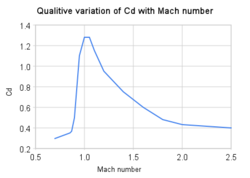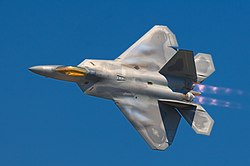History


A few early supersonic aircraft attained speeds just beyond the speed of sound without using afterburning.
On 3 August 1954, a Gerfaut research aircraft powered by an SNECMA Atar 101D2A engine exceeded Mach 1 in level flight without using afterburning. [4] [5]
The first production aircraft to exceed Mach 1 in level flight without afterburning was the Lockheed F-104 Starfighter after its J65 engine was replaced with a J79. The maximum speed without afterburning was Mach 1.05. [6]
The P.1 prototype of the English Electric Lightning, powered by non-afterburning Armstrong Siddeley Sapphire engines, exceeded Mach 1 on 11 August 1954. A week previously, on 4 August, the P.1, WG760 flown by Roland Beamont on its maiden flight, had unknowingly exceeded Mach 1 in a climb. [7] During development testing at English Electric it was established that the Lightning had a stabilized speed capability in level flight, without afterburning, of about Mach 1.2 and for the T.4 (2-seat trainer) 1.08. [8] Flying just above the speed of sound without using afterburning, although done by the contractor as part of some flight trials does not appear to have been relevant to the operational capability of the aircraft. Service trials established intercept profiles for subsonic and supersonic targets at different altitudes with subsonic cruising at a maximum of Mach 0.95 with all supersonic speeds beyond subsonic cruise attained with afterburning. [9]
All the Fairey Delta 2 initial supersonic test flying to Mach 1.1 was done without afterburning. Selecting the afterburner, which initially only had a maximum selection with no intermediate positions, would have caused an uncontrollable rapid acceleration to potentially hazardous speeds; i.e., too far beyond previously established flutter-free speeds. [10]
Only the supersonic transports (SST), Concorde, and the second version of the Tu-144 (the Tu-144D) spent most of their time cruising at their design speeds without needing afterburning. Afterburning was added to Concorde for take-off to cope with weight increases that came after the initial design. It was also used to accelerate through the high-drag transonic speed range, not because the extra thrust was required, but because it was available and improved the operating economics. The redesigned Tu-144D used engines with no afterburners which, together with other improvements, increased the full payload range from 3,080 to 5,330 km (1,910 to 3,310 mi) (Concorde's operational range was 6,470 km or 4,020 mi). [11]




